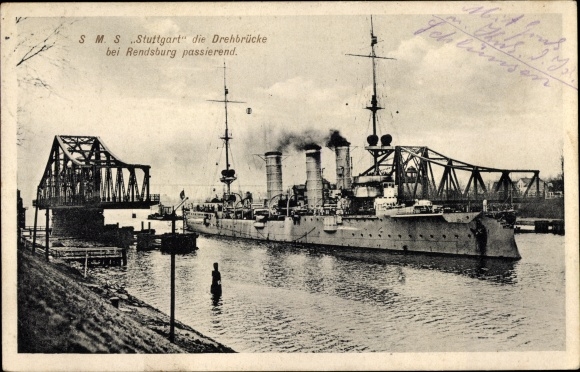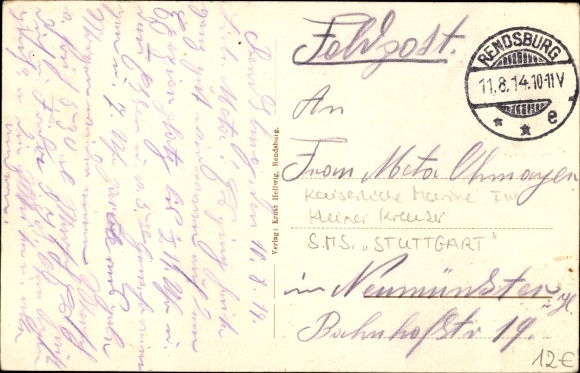

|
| DEUTSCHLAND | GERMANY |
| Bundesland: Schleswig-Holstein | |
| Kreis: Rendsburg-Eckernförde |
Rendsburg is situated at an elevation of 5–10 m at the Kiel Canal (Nord-Ostsee-Kanal) and the Eider river in central Schleswig-Holstein. Rendsburg is the administrative seat of the district Rendsburg-Eckernförde. The city has a population of about 28,400 (2006).
Rendsburg was founded around 1150 and was first mentioned as Reinoldesbuch in in 1199 in the 'Chronica Slavorum' of Arnold of Lübeck.
The old town was situated on an island in the river Eider which marked the border between Schleswig and Holstein. As a consequence, it was disputed repeatedly during its
history whether the city belonged to Schleswig or to Holstein. The city probably was chartered as a town in 1239; however, the first document mentioning
this status dates from 1253. Count Gerhard III ('the Great') of Holstein-Rendsburg confirmed the city's privileges in 1339.
In 1460, Rendsburg came under the rule of King Christian I of Denmark, Duke of Schleswig and Count of Holstein. The city was fortified between
1536 and 1540 under King Christian III. Further large fortifications were built after 1690. The Schleswig-Holstein Canal was built in 1777–1784 and connected
Kiel on the Baltic Sea with the river Eider which from Rendsburg flows in a westward direction into the North Sea.
The railroad from Rendsburg to Neumünster was opened in 1845. In 1848, at the outset of the First Schleswig War (1848–1851),
Rendsburg became a centre for the Prussian troops. From 1852 until 1864 Rendsburg again was under Danish sovereignty. The Schleswig-Holstein Canal was renamed Eider Canal
during this period. After the Second Schleswig War (German-Danish War) of 1864 and the Peace of Vienna, Denmark was forced to cede
Schleswig to Prussia and Holstein to Austria. Three years later, after the Austro-Prussian War of 1866, Holstein also became part of Prussia.
 After a construction period of 8 years, the Kaiser Wilhelm Canal (Kiel Canal) was opened in 1895. The canal was of great strategic importance for Germany
as it considerably shortened the sailing time between the Baltic and North Sea which took 3 or 4 days through the Eider Canal.
In 1970 the districts of Rendsburg and Eckernförde were amalgamated; the administration of the new district remained in Rendsburg.
After a construction period of 8 years, the Kaiser Wilhelm Canal (Kiel Canal) was opened in 1895. The canal was of great strategic importance for Germany
as it considerably shortened the sailing time between the Baltic and North Sea which took 3 or 4 days through the Eider Canal.
In 1970 the districts of Rendsburg and Eckernförde were amalgamated; the administration of the new district remained in Rendsburg.
 The
The  Stadttheater Rendsburg (Municipal Theatre Rendsburg) [left, no. 3822: top
left picture, and right, no. 2911] was built in 1900–1901 by the architect Albert Winckler from Altona
(Hamburg). The funds were donated by the Sparkasse (savings bank) of the city of Rendsburg. Its
original name was Stadthalle (as labeled on glass no. 2911 [left]) or Stadthallentheater.
Today, it is one of the homes of the "Schleswig-Holsteinisches Landestheater" opera, drama, and ballet companies, which since
2016 is based in Rendsburg with further stages in Flensburg, Friedrichstadt, Heide, Husum,
Itzehoe, Neumünster and Schleswig.
Stadttheater Rendsburg (Municipal Theatre Rendsburg) [left, no. 3822: top
left picture, and right, no. 2911] was built in 1900–1901 by the architect Albert Winckler from Altona
(Hamburg). The funds were donated by the Sparkasse (savings bank) of the city of Rendsburg. Its
original name was Stadthalle (as labeled on glass no. 2911 [left]) or Stadthallentheater.
Today, it is one of the homes of the "Schleswig-Holsteinisches Landestheater" opera, drama, and ballet companies, which since
2016 is based in Rendsburg with further stages in Flensburg, Friedrichstadt, Heide, Husum,
Itzehoe, Neumünster and Schleswig.
The fountain  Pfahler Brunnen [left, no. 3822: top right picture]
had been erected in front of the municipal theatre. The monumental fountain was melted down during World War I.
Pfahler Brunnen [left, no. 3822: top right picture]
had been erected in front of the municipal theatre. The monumental fountain was melted down during World War I.
The former  Imperial Post Office [left, no. 3822: bottom picture: left]
was built in 1879–1881 by the architect August Wilhelm Kind. From the early 1980s until 2012 it was used by the
Deutsche Bank. Since 2016 it used as the directorate of the Schleswig-Holsteinisches Landestheater. Some of the original
features of the building, such as the central turret, do not exist any more.
Imperial Post Office [left, no. 3822: bottom picture: left]
was built in 1879–1881 by the architect August Wilhelm Kind. From the early 1980s until 2012 it was used by the
Deutsche Bank. Since 2016 it used as the directorate of the Schleswig-Holsteinisches Landestheater. Some of the original
features of the building, such as the central turret, do not exist any more.
The building depicted on glass no. 3822 [left] to the right of the former post office is labeled
 Höhere
Höhere

The  Rendsburg High Bridge [left] across the Kiel Canal was built in 1911–1913.
The railroad bridge has a total length of 7.5 kilometres including the two ramps. The actual bridge has a length of 2,486 metres; the main span across the canal
is suspended 42 metres above the water. The two central pillars are 140 metres apart. As the railroad station of Rendsburg is situated immediately north of the bridge,
the line has to spiral down through the town district today called 'Schleife' ('Spiral').
Rendsburg High Bridge [left] across the Kiel Canal was built in 1911–1913.
The railroad bridge has a total length of 7.5 kilometres including the two ramps. The actual bridge has a length of 2,486 metres; the main span across the canal
is suspended 42 metres above the water. The two central pillars are 140 metres apart. As the railroad station of Rendsburg is situated immediately north of the bridge,
the line has to spiral down through the town district today called 'Schleife' ('Spiral').
The  SMS Wettin was built in 1899–1901 at the Schichau shipyards in Danzig (now Gdańsk).
Launched in 1901 she was commissioned in 1902.
The battleship of the Wittelsbach class had a length of 125 metres, a width of 21 metres and a draught of 7.7 metres.
The ship had a displacement of 12,596 tons and sailed at a speed of 17.5 knots, her crew was ca. 680 men. With the launch of the
HMS Dreadnought in 1906, this type of ship essentially became outdated. The Wettin served with the fleet until 1911 when she became an artillery training ship until 1914.
In 1916 the Wettin was disarmed and soon after became an accomodation and tender at Wilhelmshaven.
In 1922 the Wettin was finally scrapped at Rönnebeck (today part of Bremerhaven). The ships's bell is in the army museum at
Dresden.
SMS Wettin was built in 1899–1901 at the Schichau shipyards in Danzig (now Gdańsk).
Launched in 1901 she was commissioned in 1902.
The battleship of the Wittelsbach class had a length of 125 metres, a width of 21 metres and a draught of 7.7 metres.
The ship had a displacement of 12,596 tons and sailed at a speed of 17.5 knots, her crew was ca. 680 men. With the launch of the
HMS Dreadnought in 1906, this type of ship essentially became outdated. The Wettin served with the fleet until 1911 when she became an artillery training ship until 1914.
In 1916 the Wettin was disarmed and soon after became an accomodation and tender at Wilhelmshaven.
In 1922 the Wettin was finally scrapped at Rönnebeck (today part of Bremerhaven). The ships's bell is in the army museum at
Dresden.
Several glasses of this collection show other ships.
 The
The  Rendsburg Swing Bridge [left] across the Kiel Canal was built in 1912 near
the site of the first swing bridge that had been built in 1895 but had become to small to handle the traffic. Until 1957 the
new swing bridge also carried the district railway line Rendsburg–Schenefeld, nicknamed "Rosa". The bridge was finally
closed in 1961 and pedestrians could cross the canal only by a transporter bridge or a ferry boat. The bridge was demolished
in 1964. In 1965 a pedestrian tunnel beneath the canal was opened.
Rendsburg Swing Bridge [left] across the Kiel Canal was built in 1912 near
the site of the first swing bridge that had been built in 1895 but had become to small to handle the traffic. Until 1957 the
new swing bridge also carried the district railway line Rendsburg–Schenefeld, nicknamed "Rosa". The bridge was finally
closed in 1961 and pedestrians could cross the canal only by a transporter bridge or a ferry boat. The bridge was demolished
in 1964. In 1965 a pedestrian tunnel beneath the canal was opened.
By comparing the picture on glass no. 2804 [near left] with a postcard (see below) posted in 1914, the
ship depicted on the glass could be identified as the  S.M.S. Stuttgart
S.M.S. Stuttgart
Several glasses of this collection show other ships.


Souvenir glasses like those of this collection were frequently made based on the pictures on postcards of the time. The picture was copied and
transfered to the glass using a transfer print, which then was coloured by hand.
Compare glass no. 2804 [above left] with a postcard with the identical design [left].
[https://de.wikipedia.org/wiki/Liste_der_Kulturdenkmale_in_Rendsburg,
https://de.wikipedia.org/wiki/Schleswig-Holsteinisches_Landestheater, http://www.andreas-praefcke.de/carthalia/;
https://www.europese-bibliotheek.nl/en/Books/Rendsburg_in_alten_Ansichten_Band_2/100-128300/Article/5;
https://www.kn-online.de/Lokales/Rendsburg/Landestheater-Umzug-von-Schleswig-nach-Rendsburg-Kaiserliche-Post-im-Auge,
https://de.wikipedia.org/wiki/August_Kind, https://www.shz.de/regionales/schleswig-holstein/kultur/landestheater-intendanz-und-schauspiel-ziehen-nach-rendsburg-id10077486.html;
http://www.brueckenweb.de/2content/datenbank/bruecken/2brueckenblatt.php?bas=6136#.UZne4Epz43Y,
https://de.wikipedia.org/wiki/Rendsburger_Kreisbahn;
https://de.wikipedia.org/wiki/SMS_Nürnberg, https://de.wikipedia.org/wiki/SMS_Stuttgart,
https://de.wikipedia.org/wiki/SMS_Stettin]
![[scale]](lineal.jpg)